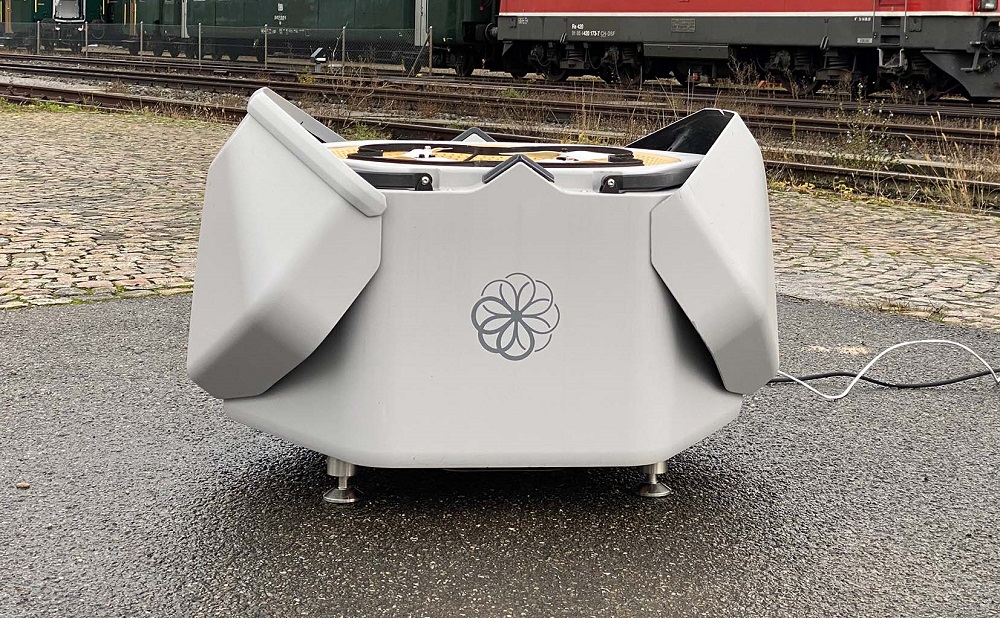As Commercial UAV News recently detailed, drone-in-a-box solutions have become a fit for a variety of applications. Automated workflows that allow drones to perform missions 24/7 without any human intervention are relevant for countless inspection purposes in industries that range from energy to construction to agriculture. However, these capabilities are just as important for security and surveillance purposes and one drone-in-a-box company is specifically focused on seeing these capabilities drive value.
The iconic Beehive System from Sunflower Labs has been developed and engineered to be the best security drone system on the market. Using a unique design of drone and landing dock, this system boasts long-distance coverage and a rapid response rate, fast installation time all at a cost around $4-5 per hour. Full details about these capabilities are available as part of the case studies on the Sunflower Labs site.
These stats are impressive, even by high-tech security standards, which is why we wanted to learn more about the Beehive System from the creators themselves. Sunflower Labs conception was borne from three friends who were frustrated by what was available in terms of security solutions. Combining their aviation, drone and technological experience, they set out to create a system that would disrupt the market and to solve issues within drone security that no one else had considered possible. We talked with one of those founders, Alex Pachikov, who serves as the Founder and CEO of Sunflower Labs, to find out what makes his product different, how it will change the present and future of the security space, and much more.
Eszter Kovacs: Tell us a bit about the inspiration behind Sunflower Labs
In 2015 I was working in software development and drones became the new, cool tech toy that everyone was playing with. I suppose the initial conception of the Beehive System started out because my house in California backed onto a huge forest. There was always strange noises that kept my wife awake, but when I went to look out the window, I couldn’t see anything. My initial thought was to grab my drone and investigate, but the technology wasn’t mature enough, so it got me thinking about what sort of capabilities you’d need for an effective security drone. 5 years on I’m pretty sure we’ve nailed it!
There are lots of drone-in-the-box solutions available on the market. What makes The Beehive system different?
Well, there wasn’t really any other drone-in-the-box solutions when we started developing the Beehive, and even now there are only about 5 or 6 shipping systems in the market. The most obvious difference is most other systems are huge, and the beauty of the Beehive is that it’s so compact by comparison (just 80cm in diameter). It makes it much more viable for companies and homeowners to install it instead of many stationary security cameras. You get so much more coverage with a drone than a security camera and you get the added benefit of having the optimal point of view at the area of interest.
Tell us a bit more about the specs. What makes the Beehive System stand out?
Well, our drones are super light at 1.56kg an have a propeller size of around 23cm (the overall size is 28x28x21cm). Our cameras are 1080p full HD res with high sensitivity in low light and operational flight time, as in a real time tested, not a lab tested time, is 15 minutes with a 5 minute safety reserve. Our drones can operate in -10C up to 40C and have an obstacle avoidance range of 6 metres. Transmission distance is max 600m and recharge time is less than 15 mins. Overall, it’s one of the highest spec drones on out there. But what really makes the Beehive System special is the landing system. We’ve put a lot of effort into get that to working just right. We wanted a really relaiable landing in bad weather conditions, and I think we’ve achieved it.

So the landing pad really is the clincher. How hard was it to get that right?
Yeah, the Hive is pretty special in our eyes because it’s so much more than just a landing pad. The entire system, drone and basestation, were developed together to be counterparts and to optimize for reliable landing system integrated charging. It is also the brains of the entire system. It processes and analyses all the data needed for the drone to work within its operational parameters and to relay information back to the cloud and apps. It also has an integrated backup battery that gives you a full hour run time if you lose power. And with an optional LTE model it can be fully wireless and still work. Getting it the landing to work in all weather conditions was hard, and it took a long time and a lot of testing to get it right, but now it works in 99% weather we normally experience.
Do you have any big projects or clients that you are working on or with at the moment?
Yes! We have just started working with the SBB in Switzerland (the national rail company). It’s a really exciting collaboration whereby we are providing security over their facilities. For example, one of their sites is is a large train and rail repair and storage facility. It’s a 35 hectare site, so pretty big. We are able to utilise the Beehive System to provide security across sites like this. In fact, you can see some of the footage on our website. We’re working on the logistics around a central system and continuous surveillance on a kind of relay format across 3 or 4 drones. It’s exciting!
Would you say the public perception of drones is improving?
There will always be a certain group of people who will feel that any form of security is intrusive. The problem is that most surveillance is intrusive, but it is subtle and nearly invisible to us, and a security drone just ends up catching people’s attention more, especially once they’ve committed a crime or done something wrong. A drone can help to act as a deterrent as well, I don’t think that people always see them that way. I mean imagine someone trying to break into your property and then hearing a drone heading their way, they’d be likely to stop and run off, right? But if you have cameras around you house, the perpetrator might not even see them can just and carry on.
And what if my neighbours have an issue with it?
This is where our system excels. We use 3d property mapping to define the property boundaries. This prevents the drone from flying or even looking outside the boundaries and therefore capturing data that is only inside your peremiter. Unless your neighbour is on your property, then it’s unlikely they’ll have anything to worry about!
The team at Sunflower Labs have clearly created a security drone system that not only disrupts the market, but that makes all other drone-in-a-box solutions look old and archaic by comparison. The Beehive System really does combine cutting edge robotics with a healthy dose of practicality to create a truly unique and effective system.
















Comments